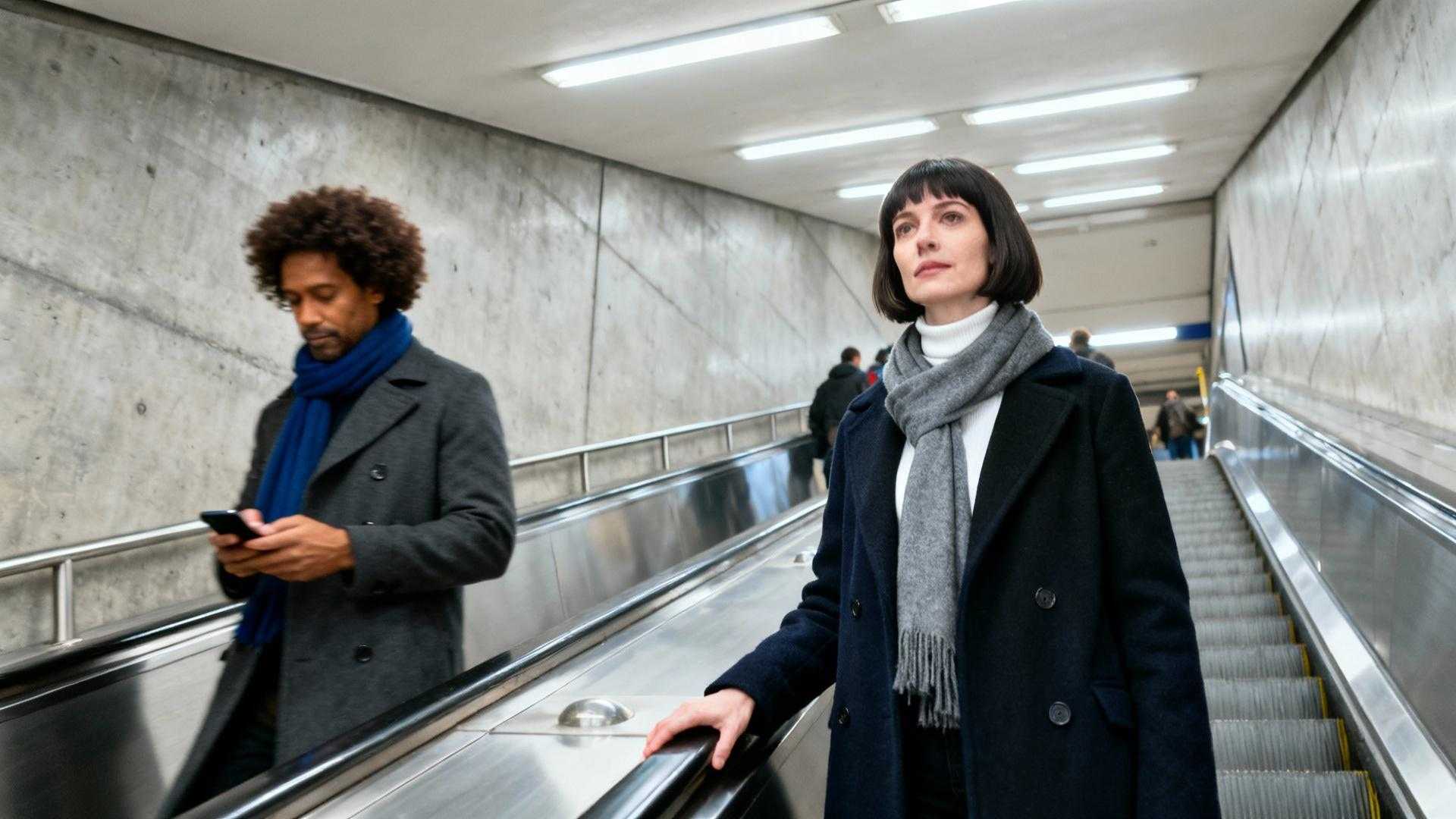The tourist stops dead in the middle of Fifth Avenue at 8:47am. Camera raised, she captures the Empire State Building while creating human chaos. Three locals execute synchronized evasive maneuvers without breaking stride. This is New York’s invisible choreography in action. Master these 7 unwritten codes and those sideways glances disappear.
The Sidewalk Is a Highway, Not a Viewing Platform
Manhattan’s sidewalks operate like multi-lane highways with 4.5 million daily pedestrians. New Yorkers walk at 4.5 feet per second compared to tourists’ leisurely 2.8 feet per second. The cardinal rule: maintain flow or move aside.
The “tourist stop” violates everything locals respect about shared space. Sudden halts for photos create pedestrian pile-ups that ripple backward for blocks. Pull to the building line before stopping, never in the center traffic lane.
Victoria Lipov from Viator explains: “Manhattan moves at an electric pace that few other cities can match. What keeps the metropolis buzzing along is a social contract that instills order.” This contract starts with respecting sidewalk flow patterns.
What New Yorkers Actually Do That Tourists Miss
The seven core codes separate residents from visitors within minutes. These aren’t posted rules or city ordinances. They’re survival mechanisms for 8.5 million people sharing 302 square miles peacefully.
Stand Right, Walk Left: The Escalator Code
Subway escalators follow strict protocols borrowed from London’s Underground system. Standing passengers occupy the right side exclusively. Climbers pass on the left side only. Breaking this rule triggers instant tourist identification and frustrated sighs.
Nick Leighton, co-host of “Were you Raised by Wolves?” podcast, notes: “The left side of escalators is to walk down and the right side is just to stand on it.” Similar morning rush protocols exist in Seoul where locals follow unspoken transit rules.
The 30-Foot Smoke-Free Perimeter Nobody Posts
NYC bans smoking within 30 feet of building entrances and throughout all 1,700 parks. Locals know this instinctively. Tourists light cigarettes on park benches and get polite corrections from park staff.
Pisit Koolplukpol observes: “NYC’s parks are smoke-free. New Yorkers respect these rules as a matter of courtesy and communal living.” Violations carry $50 fines, though enforcement focuses on education over punishment.
The Speed of NYC: Why Locals Move Like They’re Late
The brisk walking pace isn’t rudeness or aggression. It’s functional necessity in America’s densest urban environment. Every movement serves efficiency and mutual respect for shared space.
Eye Contact Isn’t Required or Expected
Avoiding prolonged eye contact on subways and sidewalks is normal social behavior. It’s how 8.5 million people maintain personal space in close quarters. This differs dramatically from Roman cultural codes where eye contact signals engagement.
The subway’s “let people exit first” rule is sacred. As one MTA conductor with 12 years experience explains: “Step off the train and out of the way so passengers can exit. Then step back on and away from the doors.”
Don’t Block the Box: Traffic and Pedestrian Ethics
Never enter intersections if you can’t clear them completely. This applies to pedestrians too. Don’t stand in crosswalks during red lights or linger in subway doorways.
Carlos Ramirez from Hell’s Kitchen Café says: “Locals value quick movement and considerate behavior on the streets. If you move with the flow, people are more welcoming than tourists expect.”
The Unspoken Order Behind the Chaos
These codes create what appears chaotic but functions smoothly. They’re not exclusionary tactics designed to intimidate visitors. They’re collaborative agreements that make dense urban living possible.
When 65 million annual tourists understand these patterns, they unlock authentic interactions locals reserve for those who respect the rhythm. Parisian etiquette rules serve similar community functions in dense European neighborhoods.
The difference between chaos and order is often invisible. New Yorkers navigate by muscle memory developed through years of subway commutes and sidewalk negotiations.
Your Questions About 7 Unwritten Codes Every New Yorker Secretly Follows Answered
What happens if I accidentally break one of these rules?
Locals might sigh, step around you, or offer direct correction. Breaking smoking bans gets polite warnings from park staff. Sidewalk rule violations trigger nonverbal annoyance like shoulder checks or exasperated exhales, but rarely confrontation.
Are these codes enforced everywhere in NYC, or just Manhattan?
Core rules apply borough-wide across all five areas. Brooklyn, Queens, and the Bronx follow identical pedestrian flow logic and escalator etiquette. Tourist-dense zones like Times Square and SoHo see the most violations daily.
How do these compare to other major city codes?
London shares escalator etiquette but Vienna demands strict café protocols NYC doesn’t require. Tokyo has stricter train silence codes. NYC emphasizes movement efficiency over quietness throughout public spaces.
By 8:52am, that same Fifth Avenue corner flows smoothly again. Locals weave through with practiced precision, each following codes learned through years of urban navigation. You’ll master them when a native New Yorker steps aside for you.
